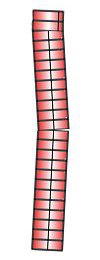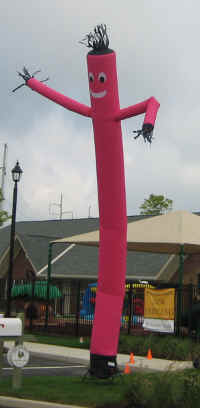Tangled, not Twirled
(er, not good)
Unlike 'Shaken Not Stirred,' 'Tangled, not twirled'
is not good. We want 'Twirled not tangled.'
Recently, though, I saw a rather high level clinician
coach someone to become tangled. I thought she was
coaching them about what not to do, but she was actually
telling them that was what they should do. (Oops)
The Visual
The visual for this is a stack of 'hockey
pucks.' Or a stack of saucers. Or a stack
of lazy Susan's. Or a tower of beads. You want
something that spins around a central axis and stands in a
column. The axis is the plumb line and should never
change shape. You spin the hockey pucks, saucers,
lazy Susan's, or beads while maintaining the plumb line and
the column. (Even in light seat and jumping seat!)
What could go wrong?
  A very typical thing that goes wrong is the
instructor says 'Look where you're going!' and the rider
whips her head around to look where she's going but
absolutely nothing else spirals or twirls, the instructor
is quiet, the rider assumes this is all good. Or
maybe the instructor even hollers at the rider if she gets
her shoulders out of whack or if her hands move or her legs
do something funny -- at which point the rider freezes with
everything facing forward and her head looking over her
shoulder or something similar. A very typical thing that goes wrong is the
instructor says 'Look where you're going!' and the rider
whips her head around to look where she's going but
absolutely nothing else spirals or twirls, the instructor
is quiet, the rider assumes this is all good. Or
maybe the instructor even hollers at the rider if she gets
her shoulders out of whack or if her hands move or her legs
do something funny -- at which point the rider freezes with
everything facing forward and her head looking over her
shoulder or something similar.
If this rider managed to keep everything in the
column and on the plumb line, the picture immediately to
the right shows how her subconscious would relay this
information to her if she were using the visual's I use and
she asked for feedback from her body.
The red shading shows that everything is still
stacked in the column, not too far left/right or
front/back, and everything is still parallel to the
ground. It's like the top two beads (C1 & C2)
have simply been spun sideways on the plumb line.
The result of this is that the joint between C2 &
C3 is doing all of the work that ideally the entire spine
would be doing. Instead of that joint spinning sideways
24º, ideally each joint would spin 1º and no one joint
would be overtaxed. If each joint spun 1º the
rider's gaze would still end up looking in the correct
direction and the rider's spine would be aligned and
flexibly moving with and absorbing the motion of the horse.
The result for the horse of the incorrect spine usage
in the rider is undue pounding of the horse's spin because
the rider's body is misaligned with the horse's
spine. There is also a training issue in that the
rider is unwittingly asking for the horse to freeze and
hold itself stiff and straight while also asking it to
bend.
C1 and C2 turn as a unit -- because C1 doesn't
turn. And neither will your head turn from C1.
C2, C1, and your head all turn together. That's the
way your bones are made to work.
Typically, when they're the 'only thing turning,' this isn't the only thing that
happens. Usually when a rider flings their head
sideways, other body parts go the other way to compensate
for this. When that happens, the plumb line is broken
and now the hockey pucks aren't parallel to the ground any
more. You get something similar to the far right
picture.
Life has just gotten monumentally worse. There
will be pain involved, probably in the lower back,
shoulders, and neck, and as for the ride, the horse will
not make its corners, won't canter properly, may fall on
it's shoulder or run out on an approach to the
fence...
Or... (here's what the
clinician was advocating)
   This
starts out the same way, or it may also actually incorporate
a correct twirl, but then there's a bending that
happens.
This
starts out the same way, or it may also actually incorporate
a correct twirl, but then there's a bending that
happens.
For a left turn, it's like you fling you head the the
left and then follow that up by leaning over to the left
bending the plumb line (so now every vertebra in your spine
is tipped towards the ground, ie not parallel to the
ground) and then lift your head. (putting a kink in
your neck for good measure.)
As I tried to make the picture for this, I'm reminded
of those silly cactus things you see in front of car lots.
Picture one of these things falling over to the side and
that's what was being taught in this clinic.
When a person does this it reminds me of how kids
pretend to be airplanes. Instead of swooping down to
the ground, though, you want to be flying level.
If the rider were to hold
their arms out like airplane wings, it would be easy to see
whether they are swooping or staying parallel to the
ground. So while we don't ride around on horse with
our arms out in the air like that, you can mentally ask
yourself, "where would my arms be if I lifted them like
that? Would the whole thing be parallel to the
ground? Would I be in the center of the saddle still?"
Again, doing this kind of thing, bending the plumb
line and tipping over, sends mixed messages to the
horse. When the rider bends the plumb line, the
request to the horse is to misalign its spine. In
this case, you're asking the horse to dig into the ground
with its front end. That may be helpful if the horse
is rearing, but it may not be so helpful when you want
lofty movement. You'll find the horse 'heavy in your
hands' and sluggish. You may also find, if you're
doing this, that you're sore and gripping and that both you
and your horse are getting stiff.
Of course, there's more, but I've decided it's better
to keep things short.
'til next time,
L
ps If you're wondering what's going on in your
specific situation, I've got over 20 years of experience
seeing these things and can give you accurate feedback and
tailored direction about what to do differently.
|




![Centered Riding Today: An Informal Talk by Sally Swift [VHS]](http://ecx.images-amazon.com/images/I/41Vn6PfhzML._SL125_.jpg)
![Centered Riding with Sally Swift [VHS]](http://ecx.images-amazon.com/images/I/51OSh9kd9iL._SL125_.jpg)

 A very typical thing that goes wrong is the
instructor says 'Look where you're going!' and the rider
whips her head around to look where she's going but
absolutely nothing else spirals or twirls, the instructor
is quiet, the rider assumes this is all good. Or
maybe the instructor even hollers at the rider if she gets
her shoulders out of whack or if her hands move or her legs
do something funny -- at which point the rider freezes with
everything facing forward and her head looking over her
shoulder or something similar.
A very typical thing that goes wrong is the
instructor says 'Look where you're going!' and the rider
whips her head around to look where she's going but
absolutely nothing else spirals or twirls, the instructor
is quiet, the rider assumes this is all good. Or
maybe the instructor even hollers at the rider if she gets
her shoulders out of whack or if her hands move or her legs
do something funny -- at which point the rider freezes with
everything facing forward and her head looking over her
shoulder or something similar.
